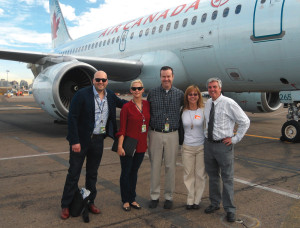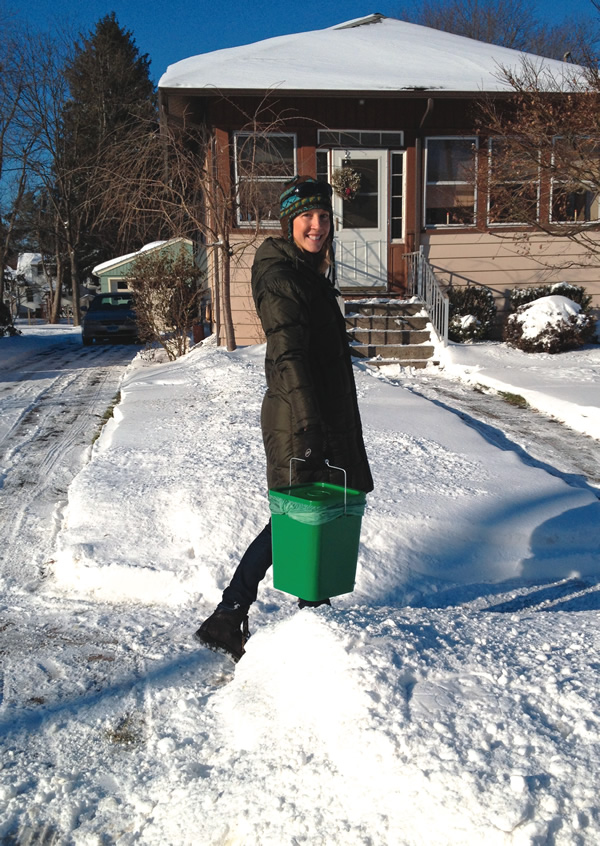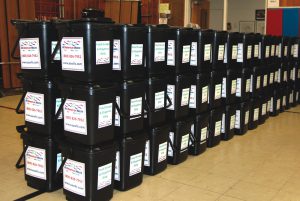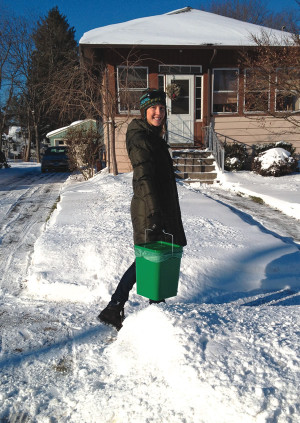BioCycle March/April 2014
Bridgewater, Connecticut: First Residential Food Scraps Collection in Connecticut
In April 2014, the town of Bridgewater will be implementing the first curbside collection program for food scraps in the state. Town officials are working with the Housatonic Resources Recovery Authority (HRRA) to operate a six-month pilot program that will provide interested residents with EcoSafe’s 2-gallon kitchen counter collection bin, 6-gallon curbside bin and compostable bags, and an information packet so households can successfully participate in the program. Jen Iannucci, HRRA’s Assistant Director, initiated the program and did much of the leg work to make the pilot a reality, including surveying community members to gauge interest and developing public education tools, like brochures and website content necessary to support the program.
“HRRA’s ongoing role in the program is to educate residents, answer questions, work out issues that arise during the pilot, coordinate the efforts of residents, the waste hauler and composters to insure a successful program, and increase the number of participants,” explains Iannucci. “HRRA will also communicate with participants on an ongoing basis, including a survey on their experience after three months, and again after six months.” All American Waste, the hauler that services 92 percent of the collection routes in Bridgewater, agreed to pilot the program for free. Food scraps will be collected weekly, with material brought to either New Milford Farms and/or New England Compost of Danbury composting facilities. Residents who participate in the program will be given voucher coupons to receive finished compost from the facilities. As of the beginning of March 2014, 140 residents had signed up for the program (of 1,100 homes in town, or about a 13 percent participation rate), as well as institutions such as the Bridgewater Village Store, Parker Medical and the Burnham School. Officials note that if the program is successful, curbside food scraps collection may expand to neighboring towns within a year. For more information on the pilot, contact Jen Iannucci (jeniannucci@hrra.org).
Austin, Texas: Curbside Organics Collection Pilot Expanded
The City of Austin is expanding its residential food scraps curbside collection pilot. In 2013, nearly 2,000 tons of source separated organics were collected from 8,000 homes as part of the city’s pilot project. In February 2014, 6,500 more homes were added, for a total of 14,000 homes currently participating. The pilot is helping Austin Resource Recovery, the city department charged with waste management, determine optimal routes, potential participation, possible contamination issues and future staffing needs. Five areas around the city were chosen to receive pick up services based on demographics and geography. For efficiency, expansion of the pilot was based on proximity to the original five areas.
The city collects food and green waste from residences weekly in 96-gallon carts. Waste eligible for composting is described in outreach materials as “If it grows, it goes!” and includes meat and dairy products. City haulers deliver collected materials to Organics by Gosh, a composting facility in Austin. Contamination has not been a huge issue according to Vidal Maldonado, Division Manager at Austin Resource Recovery. An audit of all routes indicated a contamination rate of approximately one percent, with most coming from plastics and trash, followed by glass. “We don’t allow compostable bags or any other bags so that we can see what is going into the bins,” says Maldonado. “Our biggest challenge is that participants use the cart just for food waste, instead of mixing it with yard waste. Operationally that is inefficient for us.”
These types of issues are addressed through education and outreach, including meetings with neighborhood associations to help advocate for composting. Pilot drivers participate by tagging carts and sharing educational materials with residents. In the first phase of the project overall participation was 30 percent, measured by the number of residents who set out their carts weekly (households participating irregularly were not counted). By January 2015 a report summarizing the findings from the pilot project will be presented to city management and the City Council to determine future steps for the program.
San Diego, California: Food Scraps Composting Takes Flight

San Diego International Airport is expected to collect an average of 8 tons/week of food scraps for composting, and has potential to double food donation numbers in 2014.
The San Diego International Airport (Airport) has been participating in the City of San Diego’s Commercial Food Scraps Composting Program since 2009, diverting an average of 60 tons/year of coffee grounds and fruits. During this time, the Airport had one central kitchen and 32 food providers managed by HMS Host, which also donated an average of 1,500 lbs of food annually, generating approximately 1,700 meals for food insecure San Diegans. In 2013 the Airport completed its major renovation and expansion, adding two new central kitchens managed by High Flying Foods (HFF) and SSP America (SSP). It now offers a total of 57 food vendors that include 12 sit-down restaurants, 17 fast food eateries, 11 food kiosks, and coffee shops. Twenty-nine of these vendors prepare food at their site. Once construction of the new terminals was concluded, Airport and City staff started working on a logistics plan for the comprehensive food scraps composting program including all foods, and a food donation program.
All food vendors are serviced by Flag Ship Facility Services, which took a central role in collection and contamination control from each site. The expansion of the program was divided in phases to allow staff adaptation, proper training of each group, and better control of contamination. Phase one started in December 2013, with HMS Host’s kitchen and 14 sites. This phase was successfully completed in January 2014. Phase two started on February 2014, adding HFF’s main kitchen and nine restaurants. Phase three is scheduled to start in March 2014 with SSP’s main kitchen and its 17 sites, and three sites operated by Hudson News. The San Diego International Airport is expected to collect an average of 8 tons/week of food scraps for composting, and has potential to double food donation numbers in 2014, showing a socio and environmental commitment to the region.
Charlotte County, Florida: Biosolids Composting Facility Launched
In February 2014, Synagro Technologies, Inc. opened a $4.3 million composting facility at the Zemel Road landfill in Charlotte County. Synagro worked in tandem with local and county officials, the Florida Department of Environmental Protection, and the U.S. EPA to ensure that the plant’s development, construction and operation received approval and met all regulatory requirements. The facility will operate under a 20-year lease with the Charlotte County Public Works department.
The composting plant will process only biosolids and green waste, and is not currently permitted to accept any source separated organics such as food scraps. Feedstocks are premixed, and then put into a windrow system where they are monitored for temperatures at or above 131°F for 15 days, during which the piles are turned at least five times using a Scarab windrow turner. After the 15 days, material is moved to a curing area where it stays for 30 days, before being screened with a McCloskey screener. The facility is designed to process 50,000 wet tons of biosolids and 24,000 tons of green waste. Current throughput is 35,000 tons of mixed material. The facility will produce Class AA compost, which will be retailed under the Allgro brand name. Synagro will initially target agricultural markets, but also plans to develop landscape markets for its soil amendment.
Missoula, Montana: Carcass Composting Project Protects Bears, Wolves
On many ranches, livestock carcasses are deposited in “boneyards” where they decompose. But when a ranch is near deep wilderness, boneyards may easily attract large carnivores to what seems like a free lunch, as well as increasing the chances of carnivore-human conflict and the risk that the bear or wolf will be put down. To avoid the problem, says Seth Wilson, a biologist for a coalition of ranchers and landowners in Montana called the Blackfoot Challenge — and cofounder of People and Carnivores — ranchers had sent carcasses to the local rendering plant. When that facility closed, the carcasses had to be landfilled, which is costly.
In 2007, Wilson, known as “Dr. Carcass,” asked Montana’s Department of Transportation (MDT) if it would take some livestock carcasses to the composting facility that MDT had started in Clearwater Junction to handle road-killed wildlife on a trial basis. That experiment evolved into a partnership with MDT, the Montana Fish, Wildlife and Parks Department, U.S. Fish & Wildlife Service (US FWS), and approximately 30 ranches, to compost dead livestock at MDT’s predator-resistant central facility. Livestock carcasses from the ranches go into one of 10 outdoor bins constructed of Jersey barriers and ground-up asphalt flooring. A five-wire electrical fence surrounds all of the bins and finished compost, which has “taken care of” incursions by wolves or bears, says Bruce Friede, former MDT area supervisor for Upper Blackfoot who has worked with Wilson since the project’s inception.
Carcasses are piled onto a 12- to 18-inch layer of wood chips, covered completely with higher temperature compost. A final layer of 10 to 14 inches of chips helps absorb odor, says Friede. Once the bin is full, MDT waits 30 days before “stirring” the pile. “We have to stir it because the pile is fairly large, and, as the animals are digested, it will shrink,” he explains. “We take the loader, back drag [the pile], roll it back into the bin and cover it with wood chips.” MDT adds more wood chips to control odors. In drier seasons, the pile is watered for about 15 minutes twice a day to maintain needed moisture. “If you keep it well-watered, it’s very low-odor,” notes Wilson. “When we first got started, everyone was like, is this going to be a total mess? But it’s pretty contained.” After another 30 days, MDT typically unloads the bin and puts the material into a large pile it labels “DONE”.
MDT has used the compost in various revegetation projects, such as rocky terrain surrounding a new sewer system, says Friede, noting that it got vegetation growing very quickly. “We have done some tests at the Clearwater site, where we put out 5 or 6 inches of the compost on some scree, and [the revegetation] was just amazing,” adds Wilson. “With everyone contributing, composting costs about $22/ per carcass, which is about a third what it would cost to landfill. It’s a public-private partnership 365 days a year that has kept cost down and efficiency up.”
Sonoma County, California: Worms and Worm Bins For Sale
The Compost Club started in 2003, while Rick Kaye, cofounder, was volunteering as the “recycling coordinator” for his daughter’s school in Healdsburg, California. Kaye’s mission was to divert organics that the school produced without sending the material offsite. He saw vermicomposting with worm bins as the solution. In its first year, the small, 150-student West Side School converted its 20 pounds of weekly compostable waste into worm castings. Students, teachers and parents harvested, sifted, bagged and labeled 5-pound bags of vermicompost, then sold them at the Healdsburg Farmers Market. About a half-ton of material was composted; $900 was raised for school field trips.
The Compost Club has grown from diverting 900 pounds of food scraps in 2003 to 44,000 total pounds diverted in 2013. It now includes 15 area schools and four regional businesses. The Club relies on grants and donations, and sells its worms and bin systems to the public to sustain the community project. Worms can be purchased for $25/pound. Two sizes of bins (2-feet and 3-feet in diameter and both 18-inches high) are sold locally. The Healdsburg High Construction and Sustainability Academy constructs the frames. Ordering information can be found at www.compostclub.org.
Hartford, Connecticut: Food Waste Collection Service
In late October, entrepreneur Susannah Castle launched Blue Earth Compost, a food waste collection service in Hartford and West Hartford. Castle makes weekly pick ups at residences and a local juice bar using her VW Jetta wagon. Collected organics are delivered to Harvest New England in Ellington, Connecticut, about 20 miles away. The certified-organic compost produced is periodically “returned” to Castle’s customers. For weekly pick-ups, customers pay $8/week, $30/month or $170 for six months. Blue Earth Compost supplies customers with 4-gallon bins that each hold up to 13 pounds of food waste, along with BioBag compostable liners. Castle says that she has found a lot of demand from people interested in recycling their food waste, contrary to those that believe it is difficult to change behavior in terms of getting folks to separate their organics from the waste stream and properly sort it. “We’ve audited all of our subscribers at least once and there have been no problems with contamination,” Castle adds.
Composting activity is continuing to gain momentum in Connecticut. In the beginning of 2014, state regulations came into effect that require each commercial food wholesaler or distributor, industrial food manufacturer or processor, supermarket, resort or conference center that generates more than 104 tons of organic waste per year to send that waste to an organic materials recycling facility, pending a permitted facility that is willing to accept the material exists within 20 miles of the generator. In 2020, the law will affect all generators in the above-mentioned categories, regardless of the volume of organic waste that they generate. “With the new recycling mandate, the climate has become more and more encouraging for composting, and there’s a lot of buzz around it,” notes Castle. After an article about Blue Earth Compost was published in a local newspaper, Castle says she was “inundated” with calls from prospective customers. The fact that she delivers finished compost to customers has been “a big driver” in stimulating interest.
It has been about three months since Castle began pick ups in a 5-square mile area, and she is now servicing 30 household accounts, the juice bar, and a recycling pilot project at a local grade school. Blue Earth has been adding about three new household residences per week. “We’ve been ramping up very fast, faster than our projections,” Castle adds. “Our capacity is 150 subscribers total. We are small by design. We want to innovate as we scale and grow efficiently.”















